
A trolleybus is an electric bus that draws power from dual overhead wires using spring-loaded trolley poles. Two wires, and two trolley poles, are required to complete the electrical circuit. This differs from a tram or streetcar, which normally uses the track as the return path, needing only one wire and one pole. They are also distinct from other kinds of electric buses, which usually rely on batteries. Power is most commonly supplied as 600-volt direct current, but there are exceptions.

Tehran is the capital and largest city of Iran. In addition to serving as the capital of Tehran province, the city is the administrative center for Tehran County and its Central District. With a population of around 9.4 million in the city as of 2018, and 16.8 million in the metropolitan area, Tehran is the most populous city in Iran and Western Asia, the second-largest metropolitan area in the Middle East after Cairo, and the 24th most populous metropolitan area in the world. Greater Tehran includes several municipalities, including, Karaj, Andisheh, Eslamshahr, Pakdasht, Qods, and Shahriar.

The Hamilton Street Railway (HSR) is the public transport agency for Hamilton, Ontario. The name is a legacy of the company's early period, when public transit in Hamilton was primarily served by streetcars. Although streetcars are no longer used in the city today, the HSR operates bus and paratransit services, with a ridership of 21 million passengers a year.

Amir Abad is a district in the city of Tehran, Iran.

Qeytarieh is a neighbourhood in northern Tehran, located within the larger Shemiran district. Qeytarieh has a park with the same name.
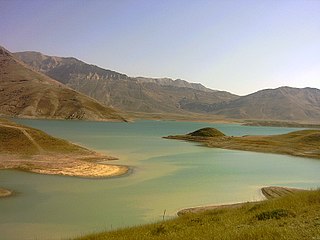
Lar Dam is a dam located at the foot of Mount Damavand in Amol county, Mazandaran, Iran. The dam is located within the protected Lar National Park, and situated just 70 kilometers northeast of the capital and the most populous city of the country, Iran. The primary purpose of the dam is municipal water supply to Tehran but prior to the water reaching the city filtration plant, it is used to power the Kalan and Lavarak Hydroelectric Power Stations, with a combined installed capacity of 162.5 MW.

Farahzad is a neighborhood in North West Tehran, the capital city of Iran. It is one of the oldest villages of Tehran. The village is over 1500 years old.

Baharestan is a locality east of the central part of Tehran in Iran. The historical Baharestan building is located in this neighborhood.
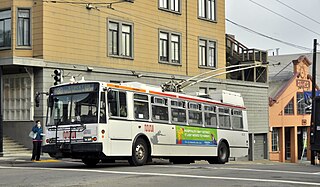
Electric Transit, Inc. (ETI) was a joint venture between the Škoda group in the Czech Republic and AAI Corporation in the United States which made trolleybuses for the Dayton and San Francisco trolleybus systems, constructing a total of 330 trolleybuses. ETI was formed in 1994, and ownership was divided as 65% by Škoda and 35% by AAI. The latter was a wholly owned subsidiary of United Industrial Corporation. Up to that time, Škoda had built more than 12,000 trolleybuses since 1935, but none for cities outside Europe and Asia. The ETI joint venture was dissolved in 2004, shortly after an unsuccessful bid to supply trolleybuses to Vancouver.
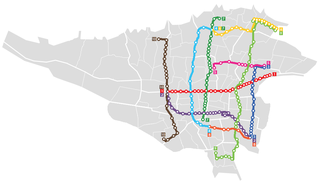
Tehran Bus Rapid Transit was officially inaugurated in 2008 in order to facilitate the motor traffic in Tehran. As at 2011 the bus rapid transit (BRT) system had a network of 100 kilometers which transports 1.8 million passengers on a daily basis.

The San Francisco trolleybus system forms part of the public transportation network serving San Francisco, in the state of California, United States. Opened on October 6, 1935, it presently comprises 15 lines and is operated by the San Francisco Municipal Railway, commonly known as Muni, with around 300 trolleybuses. In San Francisco, these vehicles are also known as "trolley coaches", a term that was the most common name for trolleybuses in the United States in the middle decades of the 20th century. In 2023, the system had a ridership of 42,240,000, or about 145,600 per weekday as of the third quarter of 2024.

The Dayton trolleybus system forms part of the public transportation network serving Dayton, in the state of Ohio, United States. Opened on April 23, 1933, it presently comprises five lines, and is operated by the Greater Dayton Regional Transit Authority, with a fleet of 45 trolleybuses. In 2023, the system had a ridership of 2,163,400, or about 5,600 per weekday as of the third quarter of 2024.
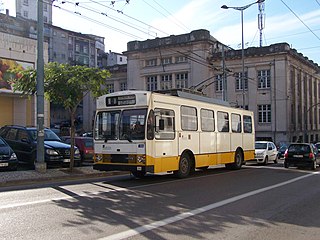
The Coimbra trolleybus system formed part of the public transport network in the city of Coimbra, Portugal. Opened in 1947, it supplemented, and then eventually replaced, the Coimbra tramway network. Service was suspended in March 2021 because of road construction, and officials stated that the suspension was temporary, but in late 2022 the mayor indicated that any resumption of trolleybus service would not occur until after completion of construction of a new Bus Rapid Transit line, around late 2024. However, in July 2024, the city council voted not to resume service – to make the suspension a permanent closure – albeit with a proposal floated for a future tourist trolleybus operation along the banks of the Mondego River, without further detail given.
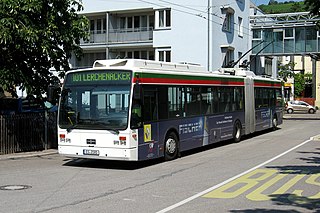
The Esslingen am Neckar trolleybus system serves the city of Esslingen am Neckar, in the Land of Baden-Württemberg, Germany.
The Melli Bank, University of Tehran Branch, was designed by Danish architect Jørn Utzon, famed for his Sydney Opera House. The three-storey rectangular building on Enghelab Street near the centre of Tehran, Iran, was completed in 1962.

The Tehran trolleybus system serves Tehran, the capital city of Iran. Opened in 1992, it is the only trolleybus system ever to have existed in Iran. At its maximum extent, the system had five routes, served by at least 65 trolleybuses. The system closed in 2013, but reopened in 2016 with one route and a fleet of around 30 modernised Škoda 15Tr.
The following is a timeline of the history of the city of Tehran, Iran.

The New Flyer Xcelsior is a line of transit buses available in 35-foot rigid, 40-foot rigid, and 60-foot articulated nominal lengths manufactured by New Flyer Industries since 2008. In addition to the different available lengths, the buses are sold with a variety of propulsion systems: conventional diesel, compressed natural gas (CNG), diesel-electric hybrid, hydrogen fuel cell, overhead electric wire and battery electric. A future autonomous bus variant was announced in January 2021.

Tehran is one of Iran's leading tourism destinations, and the city is home to an array of famous tourist attractions. In 2016, Tehran received 1.64 million foreign tourists. There are several artistic, historic and scientific museums in Tehran, including the National Museum of Iran, and the Carpet Museum. There is also the Museum of Contemporary Art, which hosts works of artists such as Andy Warhol, Pablo Picasso and Van Gogh.

The Flyer 700/800/900 series were a series of transit buses built in three generations by Western Flyer and its successors Flyer Industries and New Flyer, of Canada, between 1967 and 1987. Except for brief overlap during transition from one generation to the next, they were not in production concurrently. All individual model designations included a prefix of either D, for diesel propulsion, or E, for electrically powered trolleybuses, with the first digit indicating the generation and the last digit indicating a variant within the generation. The introductory model was the D700, originally released in 1967 for the Canadian transit market, and the last series group to be produced, D900, was discontinued in 1987. Flyer had become New Flyer only the year before, in 1986.


















